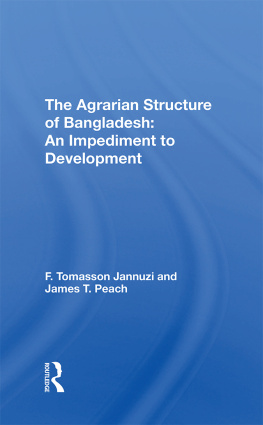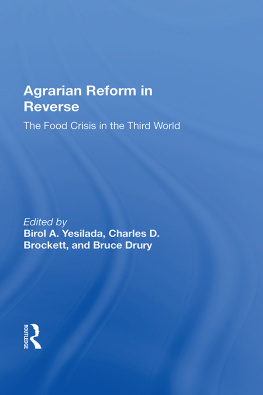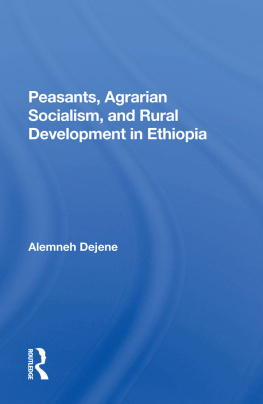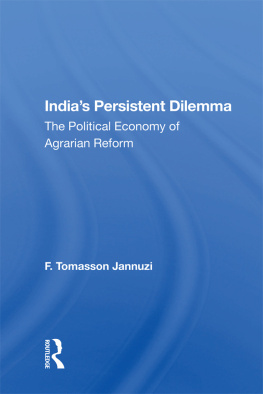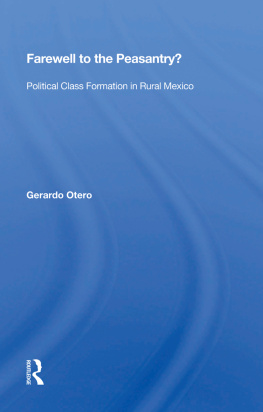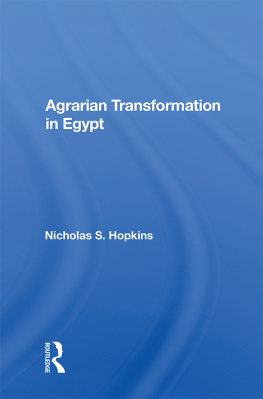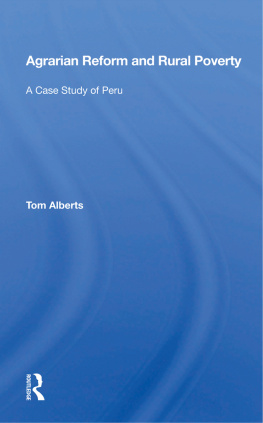The Agrarian Structure of Bangladesh
Other Titles in This Series
Indira Gandhi's India: A Political System Reappraised, edited by Henry C. Hart
Southeast Asia and China: The End of Containment, Edwin W. Martin
Intra-Asian International Relations, edited by George T. Yu
Mineral Economics and Basic Industries in Asia, K. P. Wang and E. Chin
India: A Rising Middle Power, edited by John W. Mellor
Military Power and Policy in Asian States: China, India, Japan, edited by Onkar Marwah and Jonathan D. Pollack
Also of Interest
The People's Republic of China: A Handbook, edited by Harold C. Hinton
Geography of Bangladesh, Haroun Er Rashid
Bangladesh: The Test Case for Development, Just Faaland and John Richard Parkinson
Westview Special Studies on South and Southeast Asia
The Agrarian Structure of Bangladesh: An Impediment to Development An Impediment to Development
F. Tomasson Jannuzi and James T. Peach
The relationship between the agrarian structure of Bangladesh and its problems of rural development is established in this study based on four years (1975-79) of field research. The authors suggest that the concentration of land in the hands of a rural elite is the principal impediment to the participation of weaker sections of the peasantry in economic progress. Tracing the failure of local attempts to change Bangladesh's agrarian structure by legislative means, they outline a modified program for rural development that is linked to agrarian reform.
Agrarian reform, Drs. Jannuzi and Peach argue, is the prerequisite for a rural development strategy that provides for both economic growth and improved income distribution; thus, approaches to rural development in Bangladesh that place reliance on new agricultural technology without first changing the institutions that determine peoples' relationships to the land are not viable. The authors' policy recommendations, grounded in new data on the relative proportions of owners of land, sharecroppers, and the landless, are supplemented by a theoretical analysis of the institution of sharecropping and detailed field work methodology.
F. Tomasson Jannuzi is director of the Center for Asian Studies and a member of the Department of Economics at the University of Texas at Austin. James T. Peach is also associated with the Center for Asian Studies at the University of Texas.
The Agrarian Structure of Bangladesh: An Impediment to Development An Impediment to Development
F. Tomasson Jannuzi
James T. Peach
First published 1980 by Westview Press, Inc.
Published 2019 by Routledge
52 Vanderbilt Avenue, New York, NY 10017
2 Park Square, Milton Park, Abingdon, Oxon OX14 4RN
Routledge is an imprint of the Taylor & Francis Group, an informa business
Copyright 1980 Taylor & Francis
All rights reserved. No part of this book may be reprinted or reproduced or utilised in any form or by any electronic, mechanical, or other means, now known or hereafter invented, including photocopying and recording, or in any information storage or retrieval system, without permission in writing from the publishers.
Notice:
Product or corporate names may be trademarks or registered trademarks, and are used only for identification and explanation without intent to infringe.
Library of Congress Cataloging in Publication Data
Jannuzi, F. Tomasson, 1934
The agrarian structure of Bangladesh.
(Westview special studies on South and Southeast Asia)
Bibliography: p.
1. Land tenureBangladesh. 2. Rural developmentBangladesh. 3. Land
reformBangladesh. I. Peach, James T., joint author. II. Title.
HD880.6.Z63J35 333.3'23'095492 79-17679
ISBN 13: 978-0-367-29001-6 (hbk)
There are more than eighty million people in Bangladesh, a nation-state roughly the size of the state of Wisconsin. The overwhelming majority of people are rural and dependent on agriculture for survival. Alternative opportunities for employment and income outside of agriculture are extremely limited. In these circumstances, improving the lot of the people mainly means increasing yields in agriculture and ensuring more widespread distribution of the food that is produced. These tasks are more easily verbalized than accomplished.
The people of Bangladesh are so rooted In rural poverty that there has been a tendency for some outsiders to believe that the only means of addressing their needs is to provide humanitarian aid through food shipments. Attempts to develop indigenous capacity to meet Bangladesh's problems have been based on the notion that progress in rural areas can be achieved by subsidizing the introduction of agricultural technology (high-yielding varieties of seeds, fertilizer, pesticides, and irrigation facilities). It is our thesis that the economic problems of rural Bangladesh are poorly addressed either by means of programs of humanitarian relief or of technological transfer alone. The former approach assumes that the people of Bangladesh must be beneficiaries of an international dole that meets short-term needs but does nothing to transform the basic conditions that would provide the basis for sustained economic progress. The latter approach assumes that there are no institutional or cultural impediments to technological transfer in agriculture. We believe that these assumptions are unwarranted.
Bangladesh need not be the beneficiary in perpetuity of an international dole. There is no agronomic reason that would prevent Bangladesh from producing sufficient food for its internal consumption and possibly for export. Yields per unit of land in Bangladesh can be increased enormously, even within the framework of indigenous means of production. This can be accomplished if it is recognized that the primary impediment to rural economic progress in Bangladesh is the traditional system of relationships of people to the land.
This traditional system is one in which ownership of land is divorced from personal labor on the land and investment in it. It is a system in which actual tillers of the soil must frequently give up at least 50 percent of their crop to absentee landlords. It is a system in which the primary sources of agricultural credit are usurious for actual tillers who lack a permanent right of occupancy to the land they till.
Utilizing new data from national sample surveys conducted in Bangladesh in 1977 and 1978, we will demonstrate that it is this traditional system of agriculture that must be transformed if the people of Bangladesh are to have any longterm improvement in their capacity to meet basic needs for food, clothing, shelter, employment, and income. Transforming the traditional agricultural system in Bangladesh will require changes in the agrarian structure that are difficult to invoke. The alterations required can potentially destabilize the political economy of the country, at least in the short run. This notwithstanding, we see no alternative for the government of Bangladesh but to assume the costs of transforming the traditional agrarian structure in order to establish economic and political conditions in the countryside that will confer long-term benefits on the people and government of Bangladesh.
F. Tomasson Jannuzi
James T. Peach

